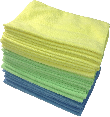Many people now wear wash-and-wear clothing. That is, you can wash the clothes in a washing machine, throw them in the clothes dryer to dry, and then simply hang them on hangers without worrying about winkles. Mostly gone are the days when people – mostly housewives – would stand over an ironing board, ironing loads of clothing on wash day while watching soap operas. That's what my mother did when I was very young. She'd wash the clothes and then hang them outside to dry, and then bring them inside to press them all afternoon long.
Today we have the advantage of better technology when it comes to garment care and choice, and I've little opportunity to use my iron and spray starch, except when I iron a few dress shirts and blouses that wrinkle in the dryer, no matter the heat setting. Even if I nab the shirts directly from the dryer as it stops, those particular blouses and shirts, made entirely of cotton, always come out of the dryer wrinkled.
What is the best way to iron a shirt or blouse? You'll need an ironing board, of course, but you'll also need a sleeve board. A sleeve board is a smaller version of your large ironing board, but quite a bit more narrow, and tapered much more at the tip to accommodate sleeves. A sleeve board is not only an excellent surface for pressing sleeves, as the name implies, it is great for pressing those hard-to-reach places, such as sleeve caps and necklines. Follow these guidelines to properly iron a shirt or blouse, using a sleeve board:
Hang the shirt or blouse immediately after ironing and continue with the next garment. Always button the top button of a shirt or blouse when hanging it, as doing so will help retain the shape of the collar.

The Power of Microfiber! Zwipes Microfiber Cleaning Cloths will become your favorite tool for every cleaning task. This 36-cloth package is perfect for hundreds of uses in the garage, kitchen, bathroom, laundry, and all around the house. Each cloth is tough, streak-free, lint-free, reusable, and washable. Check out Microfiber Cleaning Cloths today!
So many people just don't do ironing because it's seen as boring and arduous. However ironing doesn't have to be ...
Discover MoreHate those unwanted creases in your jacket sleeves? Fixing that actually isn't hard and you can live without jacket creases!
Discover MoreYou want your steam iron to operate to the best of its capacity so you need to use the right kind of water. Not using the ...
Discover MoreFREE SERVICE: Get tips like this every week in Cleaning Tips from Tips.Net. Enter your address and click "Subscribe."
2018-07-02 08:59:36
Joanne
Just read the section about using a sleeve board. I was always taught that slacks get a pleat, but never a sleeve and that a sleeve board facilitates that. And the sleeve boards is to iron around the cuff without pleating by putting the board in the sleeve. My grandmother told me that you use both ends of the ironing board, the square end for ironing the back yoke and if there is a gather (not sure what to call that) you iron from the inside of the shirt to avoid pleating.
FREE SERVICE: Get tips like this every week in Cleaning Tips from Tips.Net. Enter your address and click "Subscribe."
Copyright © 2025 Sharon Parq Associates, Inc.
Comments